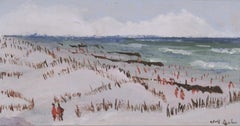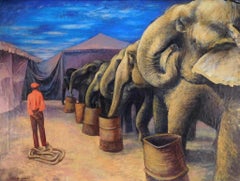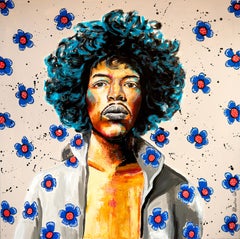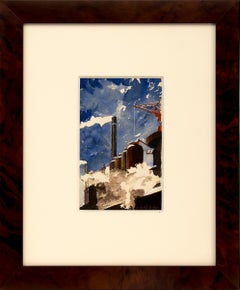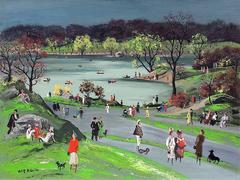Adolf Arthur Dehn Paintings
American, 1895-1968
Adolf Dehn, printmaker, watercolorist, and illustrator, was born in Waterville, Minnesota, in 1895. In 1914 he began studying at the Minneapolis School of Art, and in 1917, the year his first published drawing appeared in the progressive magazine, The Masses, he received a scholarship to study at the Art Students League in New York. There he worked with Kenneth Hayes Miller and was introduced to lithography by Boardman Robinson.
While in New York, Dehn threw himself into liberal politics. Declaring himself a conscientious objector in 1918, he was forced to spend four months in a Spartanburg, South Carolina, boot camp for refusing to serve in the armed forces and eight months as a volunteer instructor teaching painting and drawing at a hospital for war victims in Asheville, North Carolina.
Dehn spent the years 1920 to 1929 in art-related travel in Europe, primarily in Vienna and in Paris, where he made lithographs at the Atelier Desjobert. Throughout this time, Dehn exhibited his work at the Weyhe Gallery in New York and contributed drawings both to magazines abroad and to the radical journal The Masses.
Upon his return to New York in 1929, he became a leading figure in printmaking circles, exhibiting his prints to considerable critical acclaim. In 1937, Dehn had worked exclusively in black and white until 1937—halfway through his career—when he began to work in watercolor. During his summer visits to Minnesota, he created a large body of regional watercolors depicting the lakes and farms of his home state. Lithography and watercolor remained his two primary media, and his subjects ranged from social satire to naturalistic landscapes.
He authored the treatise, Water Color Painting, in 1945 and two other instructional books on lithography and watercolor in 1950 and 1955. From 1938 to 1939 he taught at Stephens College in Columbia, Missouri, and during the summers of 1940-1942 he taught at the Colorado Springs Fine Arts Center.
In 1939 and 1951 Dehn received Guggenheim Fellowships, and 1961 he was elected Full Academician to the National Academy of Design.
Dehn exhibited throughout his career, and his works are in the permanent collections of the Metropolitan Museum of Art, the Museum of Modern Art, the Art Institute of Chicago, the Museum of Fine Arts in Boston, and the British Museum, among others.
Adolf Dehn died in New York in 1968.to
3
1
Overall Width
to
Overall Height
to
4
1
1
2
3
4
1
1
1
1
3
2
1
1
1
23
784
720
704
694
4
4
Artist: Adolf Arthur Dehn
Adolf Dehn 1940s Kresge's at Christmas Time
By Adolf Arthur Dehn
Located in San Francisco, CA
Adolf Dehn: 1895-1968. Well listed American artist with a high auction record of $20,000 which was achieved this year. He was born in Minnesota and studied at Minneapolis School of F...
Category
1940s Adolf Arthur Dehn Paintings
Materials
Mixed Media
Adolf Dehn, Haitian Scene A, signed painting, Associated American Artists, 1950s
By Adolf Arthur Dehn
Located in New York, NY
Adolf Arthur Dehn
Haitian Scene A, ca. 1951
Watercolor gouache on board
Signed on the front
Frame included: held in vintage modern frame
Measurements:
Framed:
11 inches vertical by 13 inches horizontal by .75
Painting
4.5 inches by 6 inches
Watercolor gouache, hand signed; framed with AAA Gallery label verso
Signed on the front bearing the original label on the verso of Dehn's longtime gallery, the prestigious Associated American Artists Gallery, New York City.
Provenance
Associated American Artists
Frame included: held in vintage frame with original label as provenance
Dehn, an influential artist and teacher (and author of the definitive textbook of his era on watercolor painting) joined Associated American Artists gallery in 1941. Although this painting is undated, it is likely circa early 1950s, as in 1951 Dehn won a Guggenheim Fellowship, which enabled him to travel to Haiti -- the subject of this work. It was part of a series inspired by Dehn's visit to Haiti.
Dehn, an influential artist and teacher (and author of the definitive textbook of his era on watercolor painting) joined Associated American Artists gallery in 1941. Although this painting is undated, it is likely circa early 1950s, as in 1951 Dehn won a Guggenheim Fellowship, which enabled him to travel to Haiti.
ADLOF DEHN
Adolf Dehn, American Watercolorist and Printmaker, 1895-1968
Adolf Dehn was an artist who achieved extraordinary artistic heights, but in a very particular artistic sphere - not so much in oil painting as in watercolor and lithography. Long recognized as a master by serious print collectors, he is gradually gaining recognition as a notable and influential figure in the overall history of American art.
In the 19th century, with the invention of the rotary press, which made possible enormous print runs, and the development of the popular, mass-market magazines, newspaper and magazine illustration developed into an artistic realm of its own, often surprisingly divorced from the world of museums and art exhibitions, and today remains surprisingly overlooked by most art historians. Dehn in many regards was an outgrowth of this world, although in an unusual way, since as a young man he produced most of his illustrative work not for popular magazines, such as The Saturday Evening Post, but rather for radical journals, such as The Masses or The Liberator, or artistic "little magazines" such as The Dial. This background established the foundation of his outlook, and led later to his unique and distinctive contribution to American graphic art.
If there’s a distinctive quality to his work, it was his skill in introducing unusual tonal and textural effects into his work, particularly in printmaking but also in watercolor. Jackson Pollock seems to have been one of many notable artists who were influenced by his techniques.
Early Years, 1895 - 1922
For an artist largely remembered for scenes of Vienna and Paris, Adolf Dehn’s background was a surprising one. Born in Waterville, Minnesota, on November 22, 1895, Dehn was the descendent of farmers who had emigrated from Germany and homesteaded in the region, initially in a one-room log cabin with a dirt floor. Adolf’s father, Arthur Clark Dehn, was a hunter and trapper who took pride that he had no boss but himself, and who had little use for art. Indeed, during Adolf’s boyhood the walls of his bedroom and the space under his bed were filled with the pelts of mink, muskrats and skunks that his father had killed, skinned and stretched on drying boards. It was Adolf’s mother, Emilie Haas Dehn, a faithful member of the German Lutheran Evangelical Church, who encouraged his interest in art, which became apparent early in childhood. Both parents were ardent socialists, and supporters of Eugene Debs...
Category
1950s Modern Adolf Arthur Dehn Paintings
Materials
Watercolor, Gouache, Board
Jersey Shore III
By Adolf Arthur Dehn
Located in Fairlawn, OH
Jersey Shore III
Casein on Masonite, 1967
Signed lower right (see photo)
Initialed, dated and titled verso
Provenance:
Estate of the artist
Virginia Dehn (the artist's widow)
Dehn Qu...
Category
1960s American Modern Adolf Arthur Dehn Paintings
Materials
Oil
Jersey Shore III
By Adolf Arthur Dehn
Located in Fairlawn, OH
Jersey Shore III
Casein on Masonite, 1967
Signed lower right (see photo)
Initialed, dated and titled verso
Provenance:
Estate of the artist
Virginia Dehn (the artist's widow)
Dehn Quests
Created on location on the Jersey Shore. The Jersey Shore was the main playground for thousand to escape the summer heat of New York. This small painting shows Dehn's mastery of patterning color to depict movement and recreation. Part of a suite of paintings done on this theme. Within a year of it's creation, Dehn dies from a heart attack.
Casein on Masonite
Condition: Excellent
Image: 6 x 11"
Frame: 9 3/8 x 14 1/2"
Adolf Dehn, American Watercolorist and Printmaker, 1895-1968
Adolf Dehn was an artist who achieved extraordinary artistic heights, but in a very particular artistic sphere—not so much in oil painting as in watercolor and lithography. Long recognized as a master by serious print collectors, he is gradually gaining recognition as a notable and influential figure in the overall history of American art.
In the 19th century, with the invention of the rotary press, which made possible enormous print runs, and the development of the popular, mass-market magazines, newspaper and magazine illustration developed into an artistic realm of its own, often surprisingly divorced from the world of museums and art exhibitions, and today remains surprisingly overlooked by most art historians. Dehn in many regards was an outgrowth of this world, although in an unusual way, since as a young man he produced most of his illustrative work not for popular magazines, such as The Saturday Evening Post, but rather for radical journals, such as The Masses or The Liberator, or artistic “little magazines” such as The Dial. This background established the foundation of his outlook, and led later to his unique and distinctive contribution to American graphic art.
If there’s a distinctive quality to his work, it was his skill in introducing unusual tonal and textural effects into his work, particularly in printmaking but also in watercolor. Jackson Pollock seems to have been one of many notable artists who were influenced by his techniques.
Early Years, 1895-1922
For an artist largely remembered for scenes of Vienna and Paris, Adolf Dehn’s background was a surprising one. Born in Waterville, Minnesota, on November 22, 1895, Dehn was the descendent of farmers who had emigrated from Germany and homesteaded in the region, initially in a one-room log cabin with a dirt floor. Adolf’s father, Arthur Clark Dehn, was a hunter and trapper who took pride that he had no boss but himself, and who had little use for art. Indeed, during Adolf’s boyhood the walls of his bedroom and the space under his bed were filled with the pelts of mink, muskrats and skunks that his father had killed, skinned and stretched on drying boards. It was Adolf’s mother, Emilie Haas Dehn, a faithful member of the German Lutheran Evangelical Church, who encouraged his interest in art, which became apparent early in childhood. Both parents were ardent socialists, and supporters of Eugene Debs...
Category
1960s American Modern Adolf Arthur Dehn Paintings
Materials
Oil
Related Items
Circus Elephants American Modernism WPA Regionalism Mid-Century Modern Oil
Located in New York, NY
Circus Elephants American Modernism WPA Regionalism Mid-Century Modern Oil. Signed lower left.
Not much is known about Marco de Marco, but just look at...
Category
1930s American Modern Adolf Arthur Dehn Paintings
Materials
Canvas, Oil
$6,900
H 32 in W 40 in D 3 in
Portrait Jimi Hendrix Can you see me? Kehinde Wiley Chut Les Barbizons
Located in Zofingen, AG
Iconic portrait of Jimi Hendrix with all-over technique. Floral patterns elements create confusion between foreground and background. Such as an Orthodox icon, Jimi Hendrix is haloed...
Category
1920s Tonalist Adolf Arthur Dehn Paintings
Materials
Glue, Mixed Media, Oil, Spray Paint, Acrylic, Canvas
$2,851 Sale Price
23% Off
H 31.5 in W 31.5 in D 1.46 in
1950's Modernist Painting - Portrait Of Figure On Gold
By Bernard Labbe
Located in Cirencester, Gloucestershire
Gold Man
by Bernard Labbe (French mid 20th century), stamped verso
original watercolour/gouache painting on paper
overall size: 111.75 x 8.5 inches
condition: very good and ready to...
Category
Mid-20th Century Modern Adolf Arthur Dehn Paintings
Materials
Watercolor, Gouache
Supermodels in Vogue, Watercolor Fashion Painting
By Manuel Santelices
Located in Miami Beach, FL
The artist has covered New York collections for over 16 years and has interviewed, as a journalist, several fashion designers and personalities for different publications. He loves t...
Category
21st Century and Contemporary Contemporary Adolf Arthur Dehn Paintings
Materials
Paper, Ink, Watercolor, Gouache
$950
H 14 in W 11 in D 0.1 in
Paul K. Smith Vintage 1930s New Mexico Adobe Church, Denver Modernist Oil
By Paul Kauvar Smith
Located in Denver, CO
This evocative vintage oil painting from the 1930s–1940s by Denver modernist Paul K. Smith beautifully depicts a classic adobe church in New Mexico, likely insp...
Category
1940s American Modern Adolf Arthur Dehn Paintings
Materials
Oil
$2,760 Sale Price
20% Off
H 22 in W 26 in D 1.5 in
Landscape
By Marcel Emile Cailliet
Located in Los Angeles, CA
Landscape, 1940, oil on canvas, 24 x 20 inches, signed, dated and titled verso: “Marcel Cailliet ’40 – S.C.” and “Marcel Cailliet Landscape”; likely exhibited at the annual juried st...
Category
1940s American Modern Adolf Arthur Dehn Paintings
Materials
Canvas, Oil
Highway Derelict
Located in Los Angeles, CA
Highway Derelict, May, 1939, oil on canvas board, signed upper right, 18 x 20 inches, exhibited 1) Society of Independent Artists, American Society of Fine Arts (Art Students League), New York, NY, April 19 – May 12, 1940, no. 535 (noted verso, listed in catalog, and see Kantner, Dorothy, Palette Palaver, Pittsburgh Sun Telegraph, April 19, 1940 – “Helen F. Price and Ethel M. Dean, the former of Johnstown, the latter of this city, are two members of the Associated Artists of Pittsburgh who are represented in the Independent Artist’s Exhibition which opens today in New York. Miss Price is represented by . . . ‘Highway Derelict’ . . . .”), 2) Solo Exhibition of Log Cabin Paintings...
Category
1930s American Modern Adolf Arthur Dehn Paintings
Materials
Canvas, Oil, Board
Pat Buckley leaving town. From The Art, culture & society Series
By Manuel Santelices
Located in Miami Beach, FL
Movies, TV and magazines are constant source of inspiration. Fame, as fleckring and shallow it can be sometimes, is very intriguing to him.
The worlds of fashion, society and pop cu...
Category
21st Century and Contemporary Contemporary Adolf Arthur Dehn Paintings
Materials
Paper, Ink, Watercolor, Gouache
$950
H 14 in W 11 in D 0.1 in
Costume - Original Mixed Media on Paper by Alkis Matheos - Mid-20th Century
By Alkis Matheos
Located in Roma, IT
Costume is an original painting in mixed media, tempera and watercolor on paper, realized by the Greek-French artist Alkis Matheos.
Very good conditions.
Signed by artist's stamp....
Category
Mid-20th Century Modern Adolf Arthur Dehn Paintings
Materials
Mixed Media, Tempera, Watercolor
$308
H 9.85 in W 6.5 in D 0.04 in
Jefferson Market Library (Courthouse)
Located in Los Angeles, CA
This painting is part of our exhibition America Coast to Coast: Artists of the 1930s
Jefferson Market Library (Courthouse), c. 1930s, oil on canvas, 30 x 24 inches, signed lower right; presented in a newer silver painted frame
About the Painting
Writing about an exhibition of Charles W. Adams’ work at the Eighth Street Art Gallery in the mid-1930s, Emily Grenauer observed in The World-Telegram that the artist’s paintings were “distinguished for their solid form, well organized design and sumptuous color” and the art critic for The Herald Tribune found Adam’s work “a strong, formal realization of his subject . . . he paints with vital emphasis on structure and composition.” Although we do not know which works these critics referenced, it is likely they were writing about paintings like Jefferson Market Library (Courthouse). With its carefully designed reality, strong angles, solid forms, and well-disciplined puffs of smoke in the background, Adams presents a highly structured version of the Greenwich Village landmark, the Jefferson Market Library, which was a courthouse at the time Adams completed this work. The Jefferson Market Library was a prized subject for downtown painters, including the Ashcan School painter, John Sloan, the modernist, Stuart Davis, and the precisionist, Francis Criss...
Category
1930s American Modern Adolf Arthur Dehn Paintings
Materials
Oil
Snow in the Valley - Winter Landscape in Oil on Canvas
Located in Soquel, CA
Snow in the Valley - Winter Landscape in Oil on Canvas
Serene winter landscape by A. V. Gagliardi (20th Century). A valley is covered with snow, with a small house and river in thew...
Category
1970s American Modern Adolf Arthur Dehn Paintings
Materials
Canvas, Oil, Stretcher Bars
$1,300 Sale Price
29% Off
H 28 in W 22 in D 0.75 in
Autumn Color
Located in North Clarendon, VT
Striking regionalist painting by American/Hungarian artist Charles Harsanyi. Autumn Colors in Stephenstown NY. 15" x 20" Oil on board with bold brushwork housed in a 19.25 x 24.25 white washed period frame.
Charles Harsanyi (American, 1905-1973)
Charles E. Harsanyi was born in Tapolcza, Hungary in 1905. He studied at the Royal Academy in Budapest, Hungary with A. Bankhard from 1923 to 1928. Nineteen years later, in 1947, Harsanyi moved to the U. S., settling in Jackson Heights, New York.
The painter and drawing specialist became a member of numerous prestigious art clubs including the Salmagundi Club, The Society of Independent Artists and the Allied Artists of America. Harsanyi served as an awards director and chairman of admissions for the Audubon Artists Association during the 1950s.
Later in life after living in Stephentown, New York and Cape Coral, Florida, Harsanyi passed away in Fort Myers, Florida in 1973.
STUDIED
Royal Academy in Budapest, Hungary with A. Bankhard, 1923-28
MEMBER
Salmagundi Club, 1941
Brooklyn Painters & Sculptors
American Artists Congress
Society of Independent Artists
Audubon Artists Association, jury awards director, 1952; chairman admissions
committee, 1953; nominating committee, 1955, 1956
Artists Fellow
Allied Artists of America, life member; jury awards 1945; jury selection, 1954
AWARDS
Long Island Art League, 1954 (prize)
Cumberland Valley Artists, 1949, 1950, 1952 (prizes)
EXHIBITIONS:
Society of Independent Artists, 1929, 1930, 1936-40, 1943, 1944
National Academy of Design, 1933-55
Salons of America, 1934
Brooklyn Museum, 1934
Corcoran Gallery, 1935-51 (four times)
Allied Artists of America, 1935-53 (bronze medals 1944, 1953)
Doctor Saharunis Art Gallery, Naples, Florida, 1970s
American Federation of Arts traveling exhibit
Farnsworth Museum, 1950
Springfield Museum of Art, 1947-50
Denver Art Museum, 1937-39
Washington County Museum of Fine Art, 1937-46 (prizes 1938, 39, 41, 43, 54)
(gold medal 1946)
Butter Art Institute, 1953
World's Fair, New York, 1939
Baltimore Museum of Art, 1939
Art Institute of Chicago, 1941-44
Cincinnati Art Museum, 1941
Pennsylvania Academy of the Fine Arts, 1942, 1948, 1949
Salmagundi Club, 1946 (prize), 1951 (prize)
Connecticut Academy of Fine Arts, 1942, 1943, 1945, 1953, 1955 (William Bradford...
Category
1940s American Modern Adolf Arthur Dehn Paintings
Materials
Oil
Previously Available Items
Colorado Fuel and Iron Company, Pueblo, Colorado, Modernist Watercolor Painting
By Adolf Arthur Dehn
Located in Denver, CO
Untitled (Colorado Fuel and Iron Company, Pueblo, Colorado) is a watercolor on paper painting by Adolf Arthur Dehn (1895-1968). Presented in a custom frame, outer dimensions measure ...
Category
20th Century American Modern Adolf Arthur Dehn Paintings
Materials
Watercolor
H 17.25 in W 14.25 in D 1.25 in
Central Park
By Adolf Arthur Dehn
Located in Miami, FL
Signed and dated lower left, Oil on board
Doyle New York
Category
American Impressionist Adolf Arthur Dehn Paintings
Materials
Oil
The Garden of the Gods (Colorado)
By Adolf Arthur Dehn
Located in Denver, CO
A view of Garden of the Gods, near Colorado Springs, Colorado. Housed in a period frame; the framed dimensions measure 27.5 x 34 inches. Image meas...
Category
1930s American Modern Adolf Arthur Dehn Paintings
Materials
Watercolor
Adolf Arthur Dehn paintings for sale on 1stDibs.
Find a wide variety of authentic Adolf Arthur Dehn paintings available for sale on 1stDibs. You can also browse by medium to find art by Adolf Arthur Dehn in mixed media, oil paint, paint and more. Much of the original work by this artist or collective was created during the 20th century and is mostly associated with the modern style. Not every interior allows for large Adolf Arthur Dehn paintings, so small editions measuring 11 inches across are available. Customers who are interested in this artist might also find the work of William Harnden, Harold Vincent Skene, and Mervin Jules. Adolf Arthur Dehn paintings prices can differ depending upon medium, time period and other attributes. On 1stDibs, the price for these items starts at $4,750 and tops out at $11,750, while the average work can sell for $8,250.

